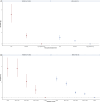Sex Differences in the Relationship of Socioeconomic Position With Cardiovascular Disease, Cardiovascular Risk Factors, and Estimated Cardiovascular Disease Risk: Results of the German National Cohort
- PMID: 39996451
- PMCID: PMC12132702
- DOI: 10.1161/JAHA.124.038708
Sex Differences in the Relationship of Socioeconomic Position With Cardiovascular Disease, Cardiovascular Risk Factors, and Estimated Cardiovascular Disease Risk: Results of the German National Cohort
Abstract
Background: Using data from the largest German cohort study, we aimed to investigate sex differences in the relationship of socioeconomic position (SEP) with cardiovascular disease (CVD), CVD risk factors, and estimated CVD risk.
Methods and results: A total of 204 780 (50.5% women) participants from the baseline examination of the population-based NAKO (German National Cohort) were included. Logistic, multinomial, and linear regression models were used to estimate sex-specific odds ratios (ORs) and β coefficients with 95% CIs of CVD, CVD risk factors, and very high-risk score (Systemic Coronary Risk Estimation-2) for CVD associated with SEP. Women-to-men ratios of ORs (RORs) with 95% CIs were estimated. In women compared with men, low versus high SEP (educational attainment and relative income) was more strongly associated with myocardial infarction, hypertension, obesity, overweight, elevated blood pressure, antihypertensive medication, and current alcohol consumption, but less strongly with current and former smoking. In women with the lowest versus highest educational level, the OR for a very high 10-year CVD risk was 3.61 (95% CI, 2.88-4.53) compared with 1.72 (95% CI, 1.51-1.96) in men. The women-to-men ROR was 2.33 (95% CI, 1.78-3.05). For the comparison of low versus high relative income, the odds of having a very high 10-year CVD risk was 2.55 (95% CI, 2.04-3.18) in women and 2.25 (95% CI, 2.08-2.42) in men (women-to-men ROR, 1.31 [95% CI, 1.05-1.63]).
Conclusions: In women and men, there was an inverse relationship between indicators of SEP and the likelihood of having several CVD risk factors and a very high 10-year CVD risk. This association was stronger in women, suggesting that CVD risk is more strongly influenced by SEP in women compared with men.
Keywords: cardiovascular disease; cardiovascular risk; educational attainment; income; socioeconomic position.
Conflict of interest statement
R.B.S. has received lecture fees and advisory board fees from Bristol Myers Squibb/Pfizer and Bayer outside this work. The remaining authors have no disclosures to report.
Figures




References
-
- Roeters van Lennep JE, Tokgozoglu LS, Badimon L, Dumanski SM, Gulati M, Hess CN, Holven KB, Kavousi M, Kayikcioglu M, Lutgens E, et al. Women, lipids, and atherosclerotic cardiovascular disease: a call to action from the European Atherosclerosis Society. Eur Heart J. 2023;44:4157–4173. doi: 10.1093/eurheartj/ehad472 - DOI - PMC - PubMed
-
- Dey S, Flather MD, Devlin G, Brieger D, Gurfinkel EP, Steg PG, Fitzgerald G, Jackson EA, Eagle KA, Global Registry of Acute Coronary Events . Sex‐related differences in the presentation, treatment and outcomes among patients with acute coronary syndromes: the global registry of acute coronary events. Heart. 2009;95:20–26. doi: 10.1136/hrt.2007.138537 - DOI - PubMed
-
- Seegers LM, DeFaria Yeh D, Yonetsu T, Sugiyama T, Minami Y, Soeda T, Araki M, Nakajima A, Yuki H, Kinoshita D, et al. Sex differences in coronary atherosclerotic phenotype and healing pattern on optical coherence tomography imaging. Circ Cardiovasc Imaging. 2023;16:e015227. doi: 10.1161/CIRCIMAGING.123.015227 - DOI - PubMed
Publication types
MeSH terms
LinkOut - more resources
Full Text Sources

